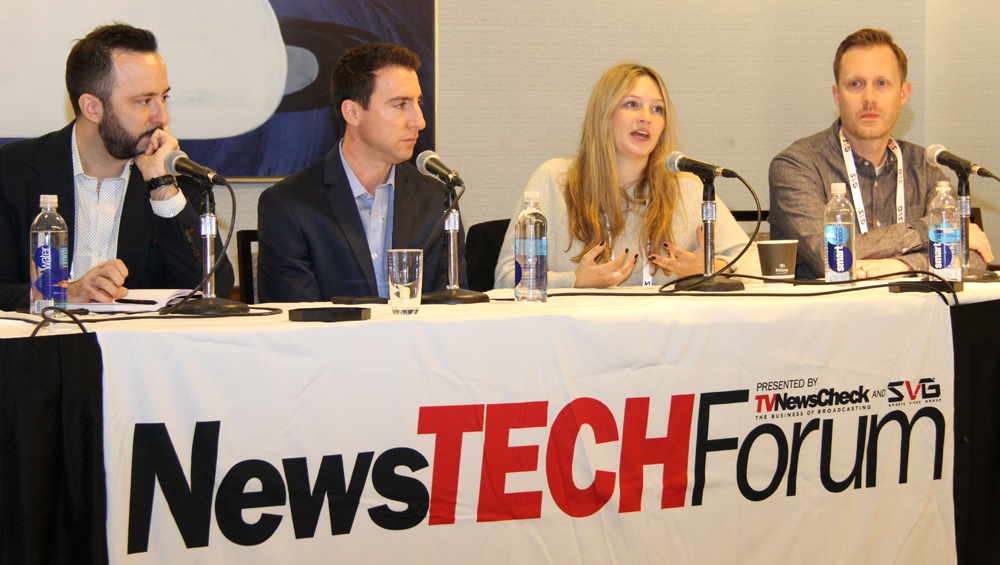
Journalists Bring Digital Aesthetic To Local News


L-r: Frederic Roux, Dalet; Matt Pearl, WXIA Atlanta; Emily Kassie, The Marshall Project; Bob Bikel, NBC Left Field. (Photo: Wendy Moger-Bross)
Broadcasters looking to engage younger viewers with their news content need to raise production values and borrow storytelling techniques from the digital world, according to a collection of journalists speaking Monday at TVNewsCheck’s annual NewsTECHForum in New York. And they may need to lose traditional notions of how viewers expect TV news to look and sound.
Bob Bikel, managing editor for NBC News’ experimental video unit, NBC Left Field, says that in working with NBC’s many seasoned journalists he often takes them into the tracking booth and urges them to deliver the news in a more casual way.
“I need to break you from doing your ‘voice’,” says Bikel. “Just tell me. Say the word ‘so’ before you say your line. Explain it to me like we’re at a bar and you just had a beer. What are you working on right now? As long as the journalism is just as impeccable, and it’s presented in a more honest way … you don’t want people to get distracted by the perfect haircut and a blazer in the middle of devastation. Those sorts of things don’t ring true to a younger audience.”
Bikel was speaking in a panel discussion, “Technology and the Next Generation of News Storytelling,” which was moderated by TVNewsCheck Special Projects Editor Michael Depp and opened by showing a collection of longer-form stories, documentary footage and digital segments that looked decidedly different than typical TV news content.
The video pieces included a story by Tegna’s WXIA Atlanta about a Georgia family whose six-year-old daughter died in Hurricane Michael in October; a snippet of a 13-minute documentary from NBC Left Field on heroin addiction and related sex trafficking in Florida; and a humorous digital segment, also from NBC Left Field, on the history of pockets in woman’s clothing and how it relates to changes in society.
The first two pieces both had a definite cinematic feel, while the third was highly graphical and incorporated Google’s Tilt Brush virtual reality technology.
The story about the family in Cairo, Ga., was shot in five hours as part of a four-part series produced by WXIA one month after Hurricane Michael, says Matt Pearl, WXIA chief of storytelling and development.
“The idea being that so often TV news stations blow in for these major events, and then a week later they’re gone, and we don’t really follow up and see what happens next,” Pearl says. “And oftentimes, what happens next, while not being immediately visually compelling, can be quite compelling both emotionally and in telling the story of the community.”
Pearl traveled to the Georgia coast by himself with two completely different camera setups — a Sony XDCAM EX-1 camcorder and a Sony mirrorless handheld unit — which he “ping-ponged” between depending on the situation. The EX-1 has a choice of lenses, including a zoom lens which Pearl used to capture storm damage, while the mirrorless unit was ideal for up-close interviews in tight spaces. For dramatic effect, Pearl also incorporated some generic background footage of a local river near WXIA, shot using a camera slider unit, into the final edit.
“I think it is an example of how cinematic can work on the local news level where time is tighter, and you need to make decisions,” says Pearl. “But if you take that extra bit of time to think about production value and setup, it can go a long way.”
The NBC Left Field documentary on the sexual trafficking of heroin addicts in Florida was produced by Academy Award-winning filmmaker Emily Kassie, who is director of visual projects for nonprofit news organization The Marshall Project and works as a freelance investigative journalist for both NBC Left Field and the New York Times. Kassie, who also produces long-form print stories to accompany some pieces, says the techniques are decidedly different when working for NBC Left Field compared to the Times but her goal is the same.
“How do I bring people in?” she says. “Well, we know that people will watch Netflix for hours, and we know that those types of stories can captivate them. So how do we use those cinematic techniques to bring viewers in and to humanize some of our characters?”
For NBC Left Field, which is a new brand, there is an emphasis on quick cuts and push-ins, and a lot of gimbel work, while the New York Times has a “completely different aesthetic.”
The sex-trafficking documentary was shot in two weeks, with Kassie reporting the piece and doing the bulk of the camera work, with the occasional aid of a second shooter. Editing, which was done in Adobe Premiere, was completed in three to four weeks with the help of two additional editors and couple of graphic artists.
Bikel, who spent time as a reporter at several TV stations before working for CNN and now NBC News, says he is well aware of the time constraints that stations face in producing in-depth pieces and that the network is trying to collaborate with them on investigative pieces where it makes sense.
On a humorous note, he says that journalists at NBC Left Field face their own challenges in trying to access archive video through the network’s Avid asset management systems. So Left Field staffers often first search for old stories through YouTube and then will give an intern the arduous task of tracking down the original source video.
Frederic Roux, director of sales, Americas for newsroom system provider Dalet, says his customers’ goals for digital content have evolved from the early days, when the mantra was simply repurposing traditional broadcast content for new platforms.
Now, he says, stations are really trying to create a digital brand and produce more long-form pieces for their digital platforms. So Dalet is incorporating artificial intelligence into its asset management system to help journalists sift through their station’s content and work more efficiently.
“Our customers want to branch out, to do more documentary-style reporting, it’s more investigative, with stronger editorial and there’s more emotional impact,” says Roux. “But to do that you still have to work within the constraints of fast-paced news production. What we’re working on a lot is creating production assistance using AI and using machine learning. So, as I start to work on a piece, instead of searching through 15 different sources, then my archive, then social, all of that is being recommended to me.”
Kassie has enjoyed great popularity online for long-form pieces she’s produced for the Huffington Post and NBC Left Field and says that creating more long-form, “nuanced” journalism is a way for local stations to grab younger viewers in an era where there is a growing dissatisfaction with the national news media. She fielded a call Monday morning from an Oklahoma station that had seen her sex-trafficking documentary and wanted to know more about how she produced it.
“I would love to see this on the local broadcast news level,” she says. “I think this is a time where this is a growing distrust of the media, a great mistrust of the media, and I think local news is a huge part of that solution.”
Here is the link to a video of this session: https://www.youtube.com/watch?v=5MACqZhJXyQ
Read all our NewsTECHForum coverage:
IP Tools Complement Old Favorites In TV News
To Win At OTT, Think Programming
OTT Is Top-Of-Mind For CBS’s Christy Tanner
NBC Stations’ Staab Underscores Localism, Tech
How Broadcasters Can Reach Young Viewers
































Comments (0)